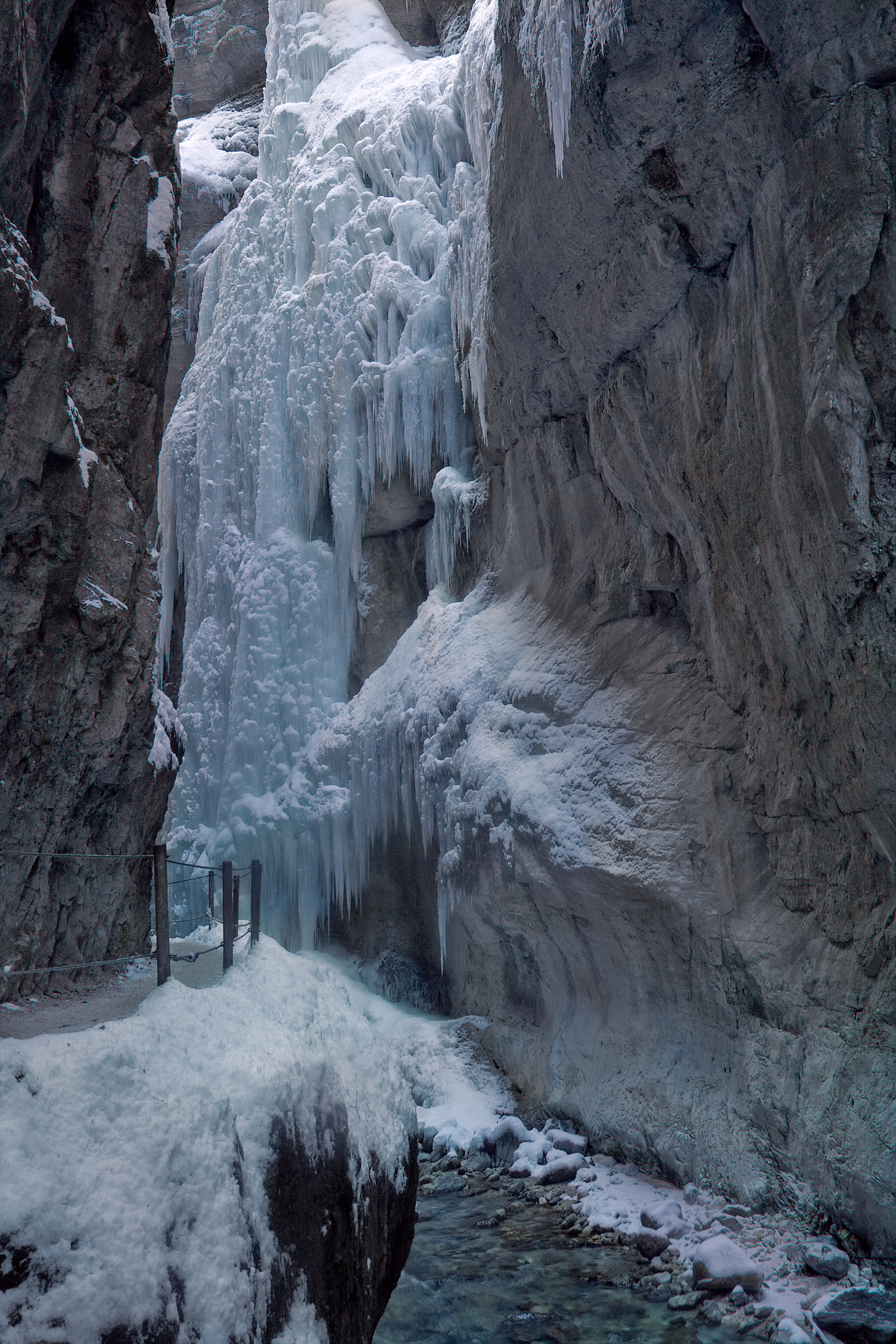Partnach Gorge on:
[Wikipedia]
[Google]
[Amazon]
 The Partnach Gorge () is a deep gorge that has been incised by a
The Partnach Gorge () is a deep gorge that has been incised by a


 In the
In the
Information on the gorge at the Bavarian State Office for the Environment
* ttp://www.allgaeu-ausfluege.de/Partnachklamm.htm Many photographs of the Partnach Gorge in summer and winter and other information
 The Partnach Gorge () is a deep gorge that has been incised by a
The Partnach Gorge () is a deep gorge that has been incised by a mountain stream
A mountain stream is a Stream, brook or stream, usually with a steep gradient, flowing down a mountainside. Its swift flow rate often transports large quantities of rock (geology), rock, gravel, soil, wood or even entire Trunk (botany), logs with ...
, the Partnach
The Partnach is an mountain river in Bavaria, Germany.
It rises at a height of on the Zugspitze Massif. The Partnach is fed by meltwaters from the Schneeferner glacier some higher up. The glacier's meltwaters seep into the karsty bedrock and ...
, in the Reintal valley near the south German town of Garmisch-Partenkirchen
Garmisch-Partenkirchen (; ) is an Northern Limestone Alps, Alpine mountain resort, ski town in Bavaria, southern Germany. It is the seat of government of the Garmisch-Partenkirchen (district), district of Garmisch-Partenkirchen (abbreviated ...
. The gorge is long and, in places, over deep. It was designated a natural monument
A natural monument is a natural or cultural feature of outstanding or unique value because of its inherent rarity, representative of aesthetic qualities, or cultural significance. They can be natural geological and geographical features such as w ...
in 1912.
Geology and origin


 In the
In the Triassic
The Triassic ( ; sometimes symbolized 🝈) is a geologic period and system which spans 50.5 million years from the end of the Permian Period 251.902 million years ago ( Mya), to the beginning of the Jurassic Period 201.4 Mya. The Triassic is t ...
, about 240 million years ago, on the bed of a shallow sea, dark grey, relatively hard layers of Alpine muschelkalk
The Muschelkalk (German for "shell-bearing limestone"; ) is a sequence of sedimentary rock, sedimentary rock strata (a lithostratigraphy, lithostratigraphic unit) in the geology of central and western Europe. It has a Middle Triassic (240 to 230 m ...
(shell-bearing limestone), so-called ''Wurstelkalk'', were laid down in the area of the present day Partnach Gorge. On the bead-like strata of this rock the traces of the burrowing and feeding of marine animals can still be seen. Importantly, about 5 million years later, softer marl
Marl is an earthy material rich in carbonate minerals, Clay minerals, clays, and silt. When Lithification, hardened into rock, this becomes marlstone. It is formed in marine or freshwater environments, often through the activities of algae.
M ...
s were deposited in the same marine basin, which today are known as Partnach Strata (''Partnach-schichten'').
In the course of the subsequent Alpine mountain folding the so-called Warnberg Saddle (''Warnberger Sattel'') was formed from these rock strata. The erosion force of the Partnach stream, fed from the Schneeferner
}
The Schneeferner in the Bavarian Alps is Germany's highest and largest glacier.Zugspitzplatt
The Zugspitze ( , ; ), at above Normalhöhennull, sea level, is the highest peak of the Wetterstein Mountains and the highest mountain in Germany. It lies south of the town of Garmisch-Partenkirchen in Bavaria, and the Austria–Germany border ...
'' plateau, was great enough to carry away quickly the softer layers, to keep pace with the continued uplifting of the terrain and thus to cut into the hard Alpine muschelkalk as well.
Today the river forms the typically narrow valley shape of a gorge
A canyon (; archaic British English spelling: ''cañon''), gorge or chasm, is a deep cleft between escarpments or cliffs resulting from weathering and the erosion, erosive activity of a river over geologic time scales. Rivers have a natural tend ...
(''Klamm'') in the area of the muschelkalk rocks, while the areas of softer Partnach strata to the north and south have a wider valley cross-section.
Economic significance
Since 1912 the gorge has been developed for tourists and can be visited all year round. An entry fee is charged in summer between 8 am and 6 pm and in winter between 9 am and 5 pm. Outside these times the gorge may be visited at individual risk.Rockfall
On 1 June 1991 about 5,000 m³ of rock broke away from a rock face at the southern end of the gorge and blocked the old path as well as the watercourse. A small, natural dammed lake was formed and the Partnach channelled its way through the giant boulders. Since 1992 a long gallery, blasted out of the rock, has bypassed the rock piles and lake. The gallery is lit by windows.In popular culture
The Partnach Gorge served as a film location for the 1979 filmNosferatu the Vampyre
''Nosferatu the Vampyre'' () is a 1979 gothic horror film directed and written by Werner Herzog. The film serves as both a remake of the 1922 film ''Nosferatu'' and an adaptation of Bram Stoker's 1897 novel ''Dracula''. Herzog’s film is set i ...
.
External links
Information on the gorge at the Bavarian State Office for the Environment
* ttp://www.allgaeu-ausfluege.de/Partnachklamm.htm Many photographs of the Partnach Gorge in summer and winter and other information
References
{{Authority control Canyons and gorges of Germany Slot canyons Landforms of Bavaria Garmisch-Partenkirchen (district) Protected areas of Bavaria